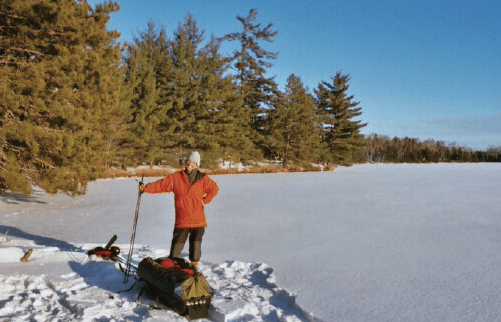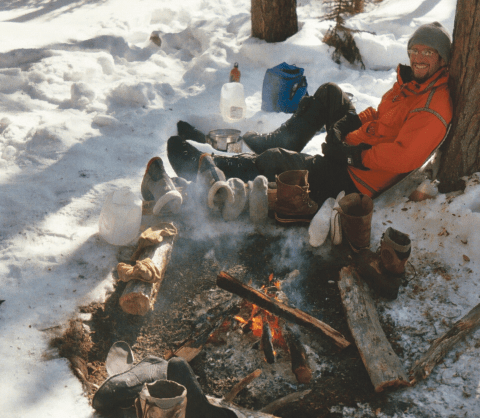
By Charlie Mahler
Here’s a Boundary Waters route I’ll bet you haven’t paddled: East out of Snowbank Lake to Disappointment Lake through Muzzle Lake to Thomas and Frazier Lakes. It’s a smooth trip, manageable in a day, and you’ll likely see some fellow hardy souls along the route.
Never paddled it? Neither have I … but I snow-shoed and skied along the route a few winters back with my soccer coach buddy Larry and we had a fantastic trip. The beaten trail was pleasant to pull our sleds along; the crusty early-March snow floated us when we “bagged” the summit of Disappointment Mountain on a day-hike; and the relatively long days gave us ample illuminated time to enjoy the white splendor that is the BWCAW in winter.
Winter travel and recreation in the BWCAW, by all accounts, is only getting more popular. A few years back, thanks to a flexible schedule and some pals as keen on exploring the wilderness in winter as I was, I spent as many winter nights in the BWCAW as summer ones. From two-night weekend jaunts, to week-long circuits through the forest, from cold, dark, turn-of-the-year trips to that sun-dazzled March mission, we found, in our familiar summer haunts, a different face of the wilderness and a new and challenging way to enjoy it.
On various winter trips we’ve slogged through stretch-upon-slushy-stretch of big lake crossings and found December lakes blown ice-rink clear of snow, we’ve packed ice cream sandwiches in our food pack and revisited and re-occupied a quinzee hut from a previous trip, we’ve punched a leg crotch-deep into the Moose River and packed a network of snowshoe trails deep into the wilderness woods.
We even got stymied by stretches of open water and thick brush along an intended path. We’ve watched wolves reconnoiter our camps, observed otters sliding along the lake-tops, and pondered the tracks left by fellow human winter travelers.
Basically, we’ve had a wintry blast!
Bring Warm Clothes
If I had to name the biggest difference between “summer” and winter travel in the wilderness – and I could be a little glib about it – I’d say there’s less opportunity for lying on the rocks with a book in winter than in summer.
That’s not to say I haven’t read a book while lying in the February sun. I have – it was a book about canoeing! But, in general, there’s more to do on the trail in winter, less time to do it – in the light, anyway – and a greater need to keep yourself moving to stay warm. After a day of snowshoeing into the wilds, there’s still firewood to gather – for warmth, not just atmosphere – a hole in the ice to chisel for water, meals to make, socks and boot-liners to dry, and thermoses to keep filled.
And a quinzee hut to build, if you’re of that ilk. I’ve tent-camped in winter, bivy-sacked on the ice, and coveted those trapper-style wall tents with their woodstoves and warmth, but I enjoy the simple, caveman pleasures of the quinzee the best.
You crawl in on your belly, admire the twigs and pine-cones cemented into the packed snow that makes your domed home, hear the snow-insulated quiet of the interior, and feel the warmth – in the high 20s, at least, no matter the wintry wickedness outside.
Another tripping buddy of mine—we’ll call him John, since that’s his name – rightly deservers the builder’s credit when I’ve “gone snow-cave.” Together we piled the snow in an excavatable heap, but after the requisite wait for all those snow-crystals to become one – called sintering – he was the one, mountaineering shovel in hand, to hollow out our home. (I was,
I hasten to add, the guy responsible for recycling the spoils onto the side of the hut and making sure the camp fire was ripping when he emerged,
jacket soaking wet, from the job.)
Aside from the boots, snowshoes, sleds, ski-poles, ice-chisel, shovels, saws, and splitting axe, the bulk of our gear amounted to warm versions of the canoe tripper’s outfit. Rather than the shorts and wind-pants of a paddle trip, we packed wind-pants, long-johns, and army-surplus wool pants. Tee-shirts were traded out for turtlenecks, windbreakers for anoraks . . . with a wool sweater and a down jacket thrown in for when the activity stopped.
Not that you’d forget, but we included lots of changes of socks, extra boot-
liners and changes of mitts and gloves . . . You only really realize how much chilling perspiration your body can make when you’re tripping in winter.
Endless Possibilities
BWCAW winter travel possibilities are practically endless. You can keep to the beaten paths if you’re new to the game and enjoy meeting fellow hardy souls along the trail. Conversely, you can tromp down new trails that will, in all likelihood, only be tromped again that season by you yourself on the homebound leg.
Three of the more traveled-by trails in the frosty wilderness start out of Moose Lake and Snowbank, in the Ely area. Via Moose, trippers can follow the mushers’ trails east toward Knife Lake or north to Basswood Lake. Both routes make winter variations to their summer counterparts.
The route to Knife sneaks through the wetlands north of Ensign Lake
to avoid the up-and-down of the summer portages. The route to Basswood eschews the open water and the extra distance of the Prairie Portage
route by sneaking through Found and Manomin Lakes to Rice Bay of Basswood Lake.
Like ice cream in the food pack, winter turns some of the basics of wilderness travel on their heads. Wetlands that would be nightmares to paddle or portage can be winter expressways. The packed dogsled trails can be especially helpful on the big lakes. They’re easy to follow – often they’re “staked out” with balsam boughs – and can keep you clear of the slush that seems to inevitably accompany freshly broken lake trails.
Where there are trails there are people. While on the Snowbank-to-Thomas route, Larry and I met a dogsledding outfitter’s group and three women coming home from a wilderness weekend. We also saw the tracks of two other parties – including some fishermen who absolutely trashed their island camp on Thomas.
On the trail between Moose and Basswood, John and I met a grouchy old fisherman, skunked for the day, muttering something about getting to Ely in time to catch his favorite TV program – NYPD Blue.
On trips we’ve made down lesser paths along the Echo Trail – sorry, that’s
all I’m willing to tell you – we saw nary a sign of fellow two-legs once we descended the wilderness side of the Echo Trail’s ditch-banks. We found lots of deep snow to break trails through, though.
Winter Wonders to Behold
Wolves trotting along a frozen lake. The view from Eagle Mountain in winter. An otter playfully sliding across the snow near the Thomas-
Frazier passage. The white expanse of mighty Basswood Lake from the top of the portage trail to Indiana Lake.
It’s not that there aren’t wonders to behold in the BWCAW in the non-winter months. I’ve seen wolves and otters and stirring vistas and mighty lakes then too. But the winter experience colors the encounters differently and makes them seem more rare, more raw. If not for your prescence, breath steaming from your parka, who would have been there to witness them? (In summer, I more often wonder what the bumbling group ahead of me just scared away!)
My English professor friend Don and I climbed Eagle Mountain two solstices ago and reveled in the view from Minnesota’s pinnacle, glad for the Eagle’s view in winter.
Wolves may reconnoiter campsites in summer from the stealth of the woods, but watching wolves surmise John’s and my Quetico camps on Agnes and Shade Lakes made the winter wilderness that much more real and visceral.
Enjoying an otter as he slid around above the open water near the connecting passage between Thomas and Frazier Lakes made me think that having fun in the woods, in winter, wasn’t just a human thing.
Winter in the wilderness has the effect, on me at least, of making the land seem bigger, more wild, more remote. Winter miles seems longer and all the more honestly earned than summer ones. The distance between far points on the shore seem more vast in crystalline cold.
But the winter environment has the effect, again, on me at least, of making the camp, the campfire, and your companions on the trail – the Larrys, the Johns, the Dons – all the more important and meaningful.
With the world beyond the glow of the fire and outside the circle of conversation that much more awesome in its harshness and beauty, the camp, the fire, the friendships – “home” – serves to comfort all the more.
Gathered around a fire, prepared to dwell for the night in your sheltering winter cave, listening to frigid winds sigh through the tree-tops, one can sense human’s original civilizing elements – companionship, warmth, shelter, security – there around the campfire.
Hey friend, pass me another ice cream bar.

This article appeared in Wilderness News Fall 2007

